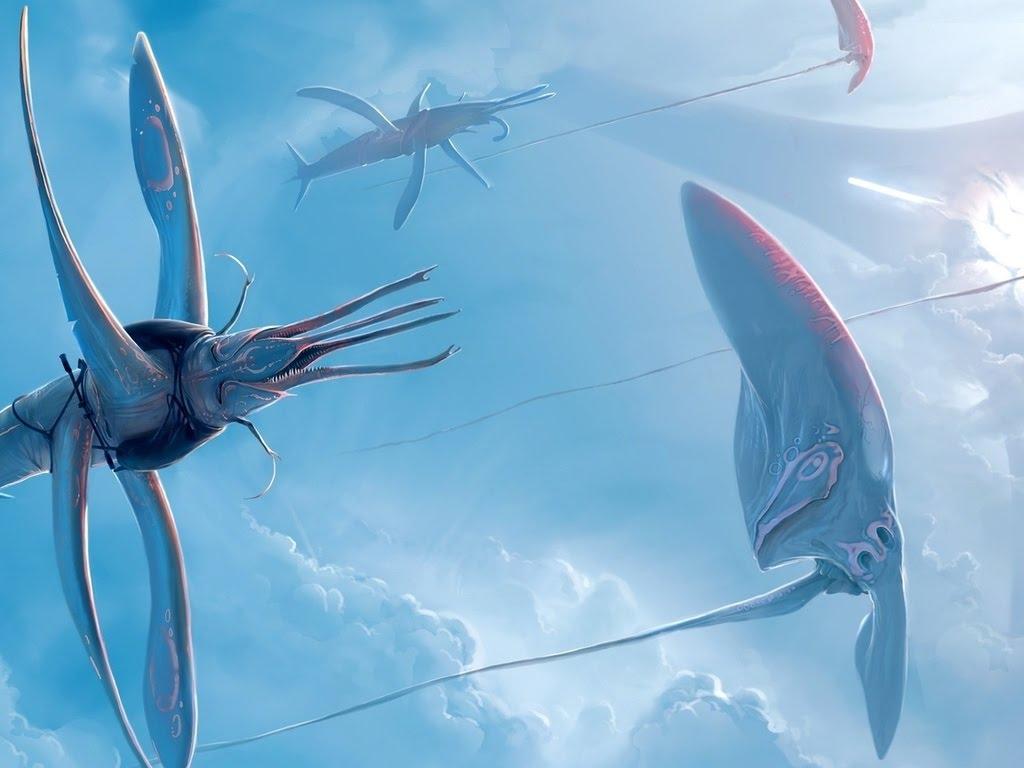
| Main | Neocene |

All pictures are taken from open sources and belong to their authors
Having no solid surface, Jupiter seems to be an unsuitable
place to live. In any case, this concerns the earth-like life. However, fundamentally
different conditions could give rise to “slightly” different creatures. That
is, ones exactly the same as on Earth, but slightly differently adapted. This,
of course, is a separate, rich topic, but attempts to construct a life significantly
different from the one we observe inevitably lead to a result that will not
work anywhere.
But for the case of Jupiter, something special does not need to be invented.
The habitable environment on giant planets can be the atmosphere only. And on
the Earth, bacteria have learned to live in clouds. For example, the gas ocean
of Jupiter includes a layer covered in clouds of water vapor, in which, at a
pressure of only three to seven atmospheres, the temperature is +30 degrees
Celsius. Like on the young Earth, there is enough ammonia, methane, hydrogen
sulfide and carbon dioxide. Similar “comfort” zones, where there is nothing
that even terrestrial bacteria could not cope with, are present in the clouds
of Saturn, Uranus and Neptune.
However, there are also some problems. Firstly, despite the fact that the ideas
about the mechanism of the appearance of life are incomplete at the moment,
it is clear that it happened not in clouds, but in solution. For the bacteria
that have already mastered the technique of synthesizing the necessary substances
the droplet moisture is sufficient – and, maybe, even the droplets of sulfuric
acid, which make up the clouds on Venus, would be just as good. However, the
emergence of life is more difficult problem. These droplets are not durable
enough to accumulate chemicals in them, forming the “primordial soup” necessary
for life at an early stage.
The second problem is gravity, which is characteristically high for giant planets.
And then an additional aggravating circumstance pops up. Giant planets are giants
because they are able to hold hydrogen in their atmospheres. Archimedes’ law
forbids anything to float in hydrogen gas. A balloon filled with hydrogen floats
in the Earth’s atmosphere consisting of heavier nitrogen. But in an atmosphere
of hydrogen, it will sink under the weight of its shell.
Both active and aerostatic flights are actually impossible on a heavy planet.
The first one will require too much energy consumption, because gravity is very
large. The second one is hampered by the extremely low density of the medium.
Although, it is only difficult, but not excluded. After all, the atmosphere
of Jupiter consists of hydrogen with 20% admixture of helium. Then, if helium
is removed from a certain volume, the lifting force, albeit negligible, will
still arise.
The most obvious lifeform in such conditions will be atmospheric phytoplankton
– microorganisms engaged in synthesis in the “comfortable” layers of the atmosphere,
where, among other benefits, the light is also present, which no longer penetrates
into the lower layers of Jupiter’s atmosphere. Bacteria will have to become
like fluff, relying on the volatility provided by the body outgrowths and ascending
gas flows. It will prolong their stay in a habitable zone, giving them time
to multiply.
But they will fall all the same, dying and dissolving in the hydrogen ocean.
Survival in sizzling hot liquid hydrogen, which is extremely chemically active
and capable of penetrating even through crystalline grid, is out of the question,
regardless of the principles on which life is built. It means that the cycling
of matter will be unclosed. The substances necessary for synthesis will be withdrawn
from the atmosphere, returning back only due to abiogenic processes. That is,
a rampant “blossoming” of clouds of Jupiter cannot be expected in any case…
By the way, it is not observed, although it would be noticed by modern means.
However, an alternative to microscopic fauna can also be giant creatures whose
size will be calculated in kilometers – living balloons using a slight difference
in density between pure hydrogen inside and hydrogen with an admixture of helium
outside their bodies to maintain volatility. This difference is really small,
and only a grand scale will allow the balloon to compensate for the weight of
the shell with lifting force. Such a creature is more likely to be a plant that
assimilates carbon dioxide, water vapor and light with its surface than an animal.
But the latter is also not excluded, in the case of symbiosis with synthesizing
microorganisms.
Theoretically, mobile creatures are also possible, keeping at the proper height
due to gliding. Colossal vortices, and hence updrafts that have existed for
centuries, technically allow an animal capable of maneuvering to stay at the
proper height in the atmosphere of Jupiter with virtually no energy expenditure.
However, this way of life involves a relatively complex organization. It is
unlikely that there will be a place for such creatures in the “unclosed” and
therefore extremely resource-poor biosphere.
Translated by Pavel Volkov, 2021
The original Russian article is here
| Main | Neocene |